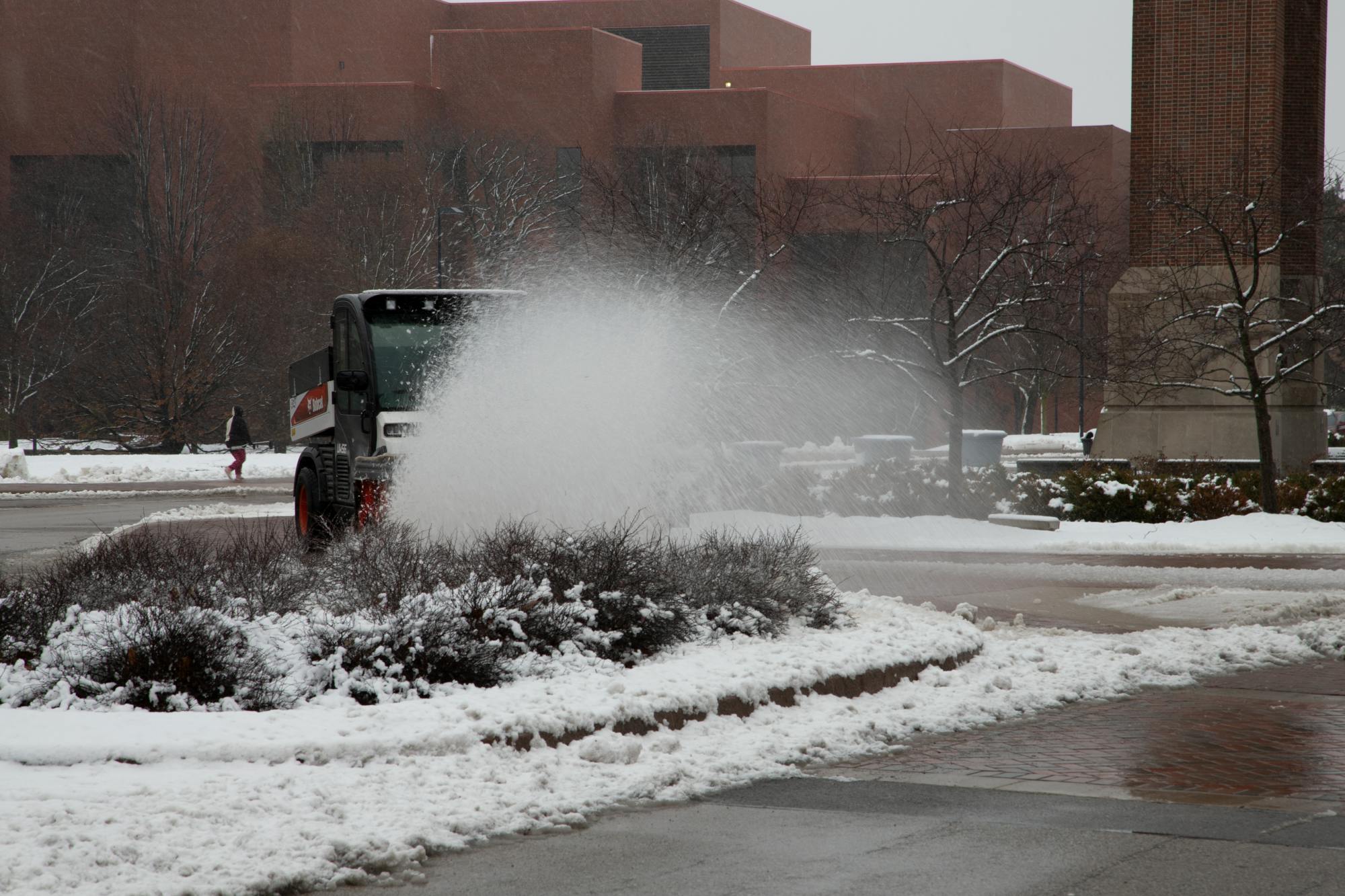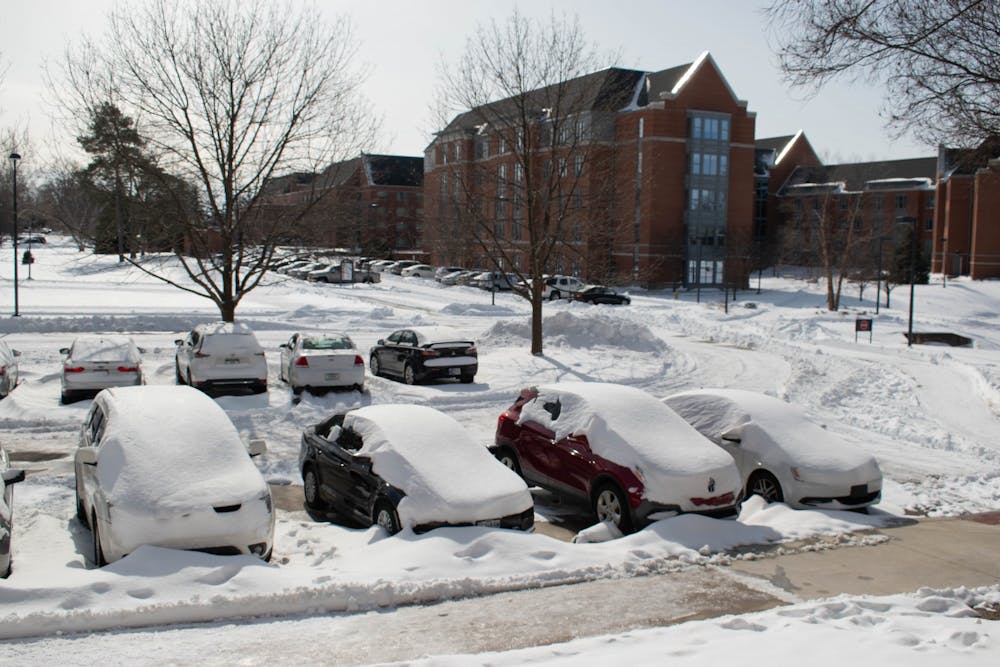With cold weather approaching, its important to make sure your car is ready and safe for travel.
According to the U.S. Department of Transportation Federal Highway Administration, 24 percent of weather-related crashes happen on snowy, slushy or icy pavement resulting in the deaths of over 1,300 people and over 116,800 injured each year.
Annually, 15 percent of crashes happen during snowfall or sleet, resulting in nearly 900 deaths and 76,000 injuries.
To help keep you safe, here’s four things to look over before you hit the roads:
Battery
It’s important to check your car’s battery life. Autozone offers free battery tests and battery charging.
If you want to test the battery at home, you can use a multimeter, which costs $16.52 at Walmart.
Charging a battery is different than jumpstarting a battery. Jumpstarting just provides the car a short burst of power to get it running, and is done when the car won’t start.
If your car dies on Ball State University’s campus, you can call Charlie Charter to jump your car.
If you need to jumpstart your car on your own, you need two things: a pair of jumper cables and willing driver to lend a helping hand, according to Toyota of Louisville. At Walmart a pair of jumper cables can cost $9.76.
Toyota of Louisville states both vehicles need to be parked and suggests to engage the parking brake for safety. After opening both hoods and locating the batteries and the terminals as well as taking off any plastic covers, its important to check for corrosion.
If there’s no corrosion, it’s time to start. Starting with the dead car, connect the red clamp to the postive terminal. Then, take the other red clamp and connect it to the working car’s positive post. Then, take the black clamp and connect it to the negative terminal on the working car. Take the last clamp and connect it to an unpainted piece of metal on the surface of the dead car.
During the whole process of connecting cables, its important the cables don’t touch each other, according to Home Depot.
Once everything is connected, it’s time to start the car. It’s important to jumpstart the car with a good battery, according to Toyota.
After the car is jumped, take the cables off in the reverse order of how they were put on, according to Progressive.

Tires
Cold temperatures effect tire pressure. Low tire pressure results in loss of traction, fuel efficiency and if they’re too low tire blowout.
According to Belle Tire, winter tires provide better traction and more secure driving when temperatures fall below 45 F. Winter tires for a passenger car are $100-$150 per tire, light trucks and SUVs $200-$400 and high-performance vehicles range from $100-$600 with the tires lasting up to four winter seasons, according to Belle Tire.
Belle Tire recommends getting the tires if you’re in an area that experiences prolonged temperatures below 45 degrees Fahrenheit.
Fluids
Though it’s important year-round, it’s especially important to check your car fluids. Get the oil checked, and if it’s dirty get it changed, and while you’re at the mechanic's have them check the other fluids and get them filled, according to Progressive.
Progressive also recommends keeping the gas tank at least halfway full to avoid moisture in the gas lines, which can freeze in cold temperatures.
Due to winter’s bad visibility, it’s important to check your windshield wipers and wiper fluid. If you live in colder areas, invest in wiper fluid that has antifreeze in it.
To check the wipers, Home Depot recommends running your finger along the rubber of the blades, feeling for cracks or tears. If they need to be replaced, either take a tape measure and note the exact length of all the wipers or look in your car’s owner’s manual.
Before doing any repairs, turn the car off. To remove the old wipers lift them off the windshield till they extend on their own, and then find a small tab, tabs or buttons on the bottom of the blade. Push that button and pull the center of the blade to the bottom of the arm, and then slide the blade off.
To put on the new ones, look at the plastic clip at the end of the wiper that connects it to the arm. One end has a slight curve and the other is flat. Align the curved end of the blade with the curved end of the arm. Take the hook on the arm and put it over the blade’s plastic clip. Pull the blade upward and tightly, so the clip’s edge clicks into place.
Once down, put the blade back down, gently. Home Depot recommends doing a wiper at time so that you have a reference when putting it back on.
Winter Precautions
Along with all of the mechanical precautions, it’s important to pack the car up with winter precautions, just in case the car gets stranded.
Some essentials recommended to have stocked in your car are a cellphone charger or a portable charger, jumper cables, flares, ice scrapers, a shovel, blankets and a coat. For traction, it’s nice to have a bag of sand or kitty litter, according to Firestone. First aid kits as well as water and snacks are recommend as well.
The Center for Disease Control and Prevention (CDC) recommends if you get stranded to focus on yourself and the passengers in your car and stay with your car. Make yourself visible to rescue workers by either tying bright fabric to the door or antenna of your car, turning on the dome light at night when running the engine and if it's not snowing, putting your hood up.
After making yourself visible, wrap your body up with coats, blankets and anything else to prevent hypothermia. Run the car for 10 minutes every hour to run the heater and charge your phone.
While running the car, open a window slightly to let fresh air in and prevent carbon monoxide (CO) poisoning. Make sure the exhaust pipe is clear of snow as well to avoid CO poisoning
Contact Hannah Amos with comments at hannah.amos@bsu.edu or on X @Hannah_Amos_394.





